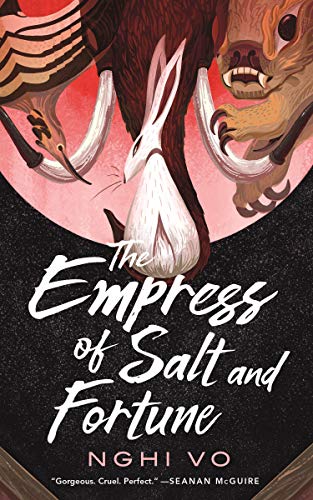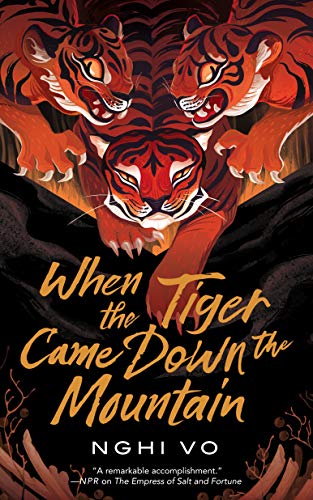Look, I can’t pretend to keep up with the outpouring of fine SFF writing we are now witnessing, so I’m dipping into the recent past to discuss a pair of stories that are so perfect in their way that it’s hard to write about them. Nghi Vo is a storyteller of dazzling gifts, and her Singing Hills Cycle of two novellas (The Empress of Salt and Fortune and When the Tiger Came Down the Mountain) shows an artist working at peak in a form that seems perfectly suited to her talents. But with her full length novel, The Chosen and the Beautiful, a reimagining of The Great Gatsby, coming out next month, it’s a good bet she will show equal mastery of the longer form.
Her sureness of pacing is one of the aspects of Nghi Vo’s writing that makes me think she’ll handle the longer form equally well. In both of these novellas, she sets aside most of the usual devices of plot used to build to a climax and gradually unfolds the stories in her own way. The Singing Hills Cycle demands close reading, but each sentence is pure pleasure.
The Empress of Salt and Fortune has a love story that gives special poignancy to the narration and a revenge tale that contributes to the overall impact. But these become clear later in the story while the telling draws us in on multiple levels.
Nghi Vo reveals the story gradually as we are introduced to the nonbinary Cleric Chih, whose training is to record everything they encounter to add to the library at their order of Singing Hills. With them is a talking hoopoe, Almost Brilliant, who has a perfect memory and can capture any detail that Chih might miss. They travel to the Scarlet Lake, named for its rare display of bioluminescence, and the location of the home in exile of the Empress from the north, In-yo, who was banished by the Emperor Zhang after giving him an heir.
There they meet an aged woman, known as Rabbit, who was In-yo’s trusted maidservant during her exile. It is she who begins to tell Chih and Almost Brilliant the “true” story of Thriving Fortune, the grimly joking name given to the Empress’s home in exile.
We then hear the story through Rabbit’s memories but also through the artifacts left by In-yo. Chapters begin with careful descriptions of the “evidence” contained in these items, each detail of which carries symbolism that Rabbit interprets for Chih. These slowly reveal the secrets of In-yo’s efforts to contact her family from the north so that they can send help and free her from isolation. The Emperor’s ambassador, the Minister of the Left, is no less careful to intercept and suppress every one of her messages. Yet, while that may provide the bones of structure, the deeper interest is in the nature of storytelling and its interplay with memory.
The beauty of Nghi Vo’s writing is not just in its careful construction of sentences and its penetrating imagery but even more in the depth of the ideas she is conveying. They force you to think carefully about each detail contributing to the overall effect. In describing the Empress, she is aware that “history” will refer to her as an ugly woman, but Rabbit denies that: “She had a foreigner’s beauty, like a language we do not know how to read.” Or in commenting on scrolls of verses, Rabbit says, “In those days you could say a thousand things with your choice of ink and paper even before someone read a word of your poetry.” When describing the Emperor Zhang’s efforts to understand the future, she says: “He read the future in ivory tablets that clacked on the floor like broken teeth, and whichever you turned up would tell you which way to go.”
These few lines give you a sense of the power of Nghi Vo’s writing without revealing too much about the powerful story of this first novella of the Singing Hills Cycle. She immerses you through telling details in a vast world in less than a hundred pages. Her subject is memory filtered through time and many minds to come together in a subtle tale of imperial intrigue. It is an unforgettable masterpiece.
The second Singing Hills novella, When the Tiger Came Down the Mountain, is just as compelling and beautifully complex but in a much different way. This novella uses a more overt story structure, that of the storyteller having to tell tales to stay alive. There is the foreground story of Cleric Chih telling tales to a tiger who not only speaks but can turn into the human form of a woman. Sinh Loan and her two sisters have cornered Chih and his guide on a trail into the mountains. While riding a mammoth, they have come to the aid of someone about to be killed by Sinh Loan and all take refuge from the tiger and her two sisters in a large open mountain shelter.
Sinh Loan invites or demands Chih to tell stories, and if they can keep Sinh Loan’s interest, she will hold off eating them. Chih draws on their knowledge of tiger etiquette to address Sinh Loan in terms of respect, and that seems to soften her attitude, adding another dimension to the foreground story.
The interest shifts to the stories Chih tells of the Scholar Dieu and the tiger Ho Thi Thau. Chih explains that these have come down to them long after their deaths by very indirect means, from a traveling actor who told them to a literate friend. So there are possible distortions after fifty years through the minds of a natural storyteller and a monk who hears them. Chih invites corrections to involve Sinh Loan in the telling and to gain a more accurate record.
And Sinh Loan obliges, offering her own commentary and adding details, often in exasperation at how far off the mark Chih’s versions are. She finally tells the story herself with a very different outcome. So here again the focus is on memory and radically different points of view, that of the scholar and of the “other.” The same story becomes very different when told not just from different points of view but from completely different traditions.
In the end, as Si-yu, Chih’s guide says, the truth is the action that explodes both in the story of the Scholar Dieu and the Tiger Ho Thi Thao and the foreground tension between humans, tigers and mammoths. This is one of the strangest love stories imaginable, whichever version you choose to believe. I can’t help but feel in the end that Cleric Chih has not heard the last from Sinh Loan.
The Singing Hills Cycle is as close to perfection as can be, and I hope more stories of Cleric Chih will follow. In the meanwhile, we will soon have Nghi Vo’s very different story of a reimagined The Great Gatsby to look forward to.






Leave a Reply